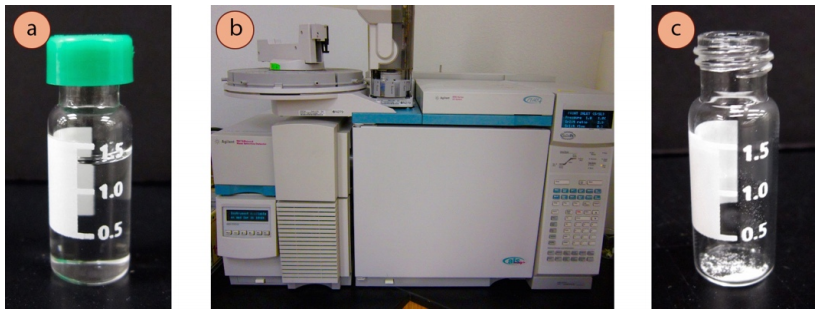2.5F: Sample Preparation for Gas Chromatography
- Page ID
- 95702
\( \newcommand{\vecs}[1]{\overset { \scriptstyle \rightharpoonup} {\mathbf{#1}} } \) \( \newcommand{\vecd}[1]{\overset{-\!-\!\rightharpoonup}{\vphantom{a}\smash {#1}}} \)\(\newcommand{\id}{\mathrm{id}}\) \( \newcommand{\Span}{\mathrm{span}}\) \( \newcommand{\kernel}{\mathrm{null}\,}\) \( \newcommand{\range}{\mathrm{range}\,}\) \( \newcommand{\RealPart}{\mathrm{Re}}\) \( \newcommand{\ImaginaryPart}{\mathrm{Im}}\) \( \newcommand{\Argument}{\mathrm{Arg}}\) \( \newcommand{\norm}[1]{\| #1 \|}\) \( \newcommand{\inner}[2]{\langle #1, #2 \rangle}\) \( \newcommand{\Span}{\mathrm{span}}\) \(\newcommand{\id}{\mathrm{id}}\) \( \newcommand{\Span}{\mathrm{span}}\) \( \newcommand{\kernel}{\mathrm{null}\,}\) \( \newcommand{\range}{\mathrm{range}\,}\) \( \newcommand{\RealPart}{\mathrm{Re}}\) \( \newcommand{\ImaginaryPart}{\mathrm{Im}}\) \( \newcommand{\Argument}{\mathrm{Arg}}\) \( \newcommand{\norm}[1]{\| #1 \|}\) \( \newcommand{\inner}[2]{\langle #1, #2 \rangle}\) \( \newcommand{\Span}{\mathrm{span}}\)\(\newcommand{\AA}{\unicode[.8,0]{x212B}}\)
Liquid GC Samples
- Fill a GC vial to the \(1.5 \: \text{mL}\) mark (Figure 2.93a) with a low boiling solvent (e.g. methanol, clean acetone, diethyl ether, or dichloromethane). Add one drop of the sample to be analyzed. If you think you possibly only added a half-drop, it's probably enough. Two drops are really too much.
- Cap the vial and invert once or twice to dissolve the sample. If it appears like the sample drop did not dissolve fully, prepare another sample using a different solvent.
- Alternatively, if you have already prepared a high-field NMR sample, use one-third of this sample and dilute it further with a low-boiling solvent.
- Run the GC, as demonstrated by your instructor. Procedures vary at each institution.

Solid GC Samples
- Some relatively volatile solids (never ionic solids!) can be analyzed by GC. Add one or two "specks" of solid\(^{16}\) (a pile approximately \(2 \: \text{mm}\) in diameter), or a very small spatula-tip of solid to a GC vial (Figure 2.93c). Then add a low boiling solid (e.g. methanol, clean acetone, diethyl ether, or dichloromethane) to the \(1.5 \: \text{mL}\) mark.
- Cap the vial and invert several times to fully dissolve the solid. If the solid dissolves, run the GC.
- If the solid does not dissolve, do NOT run the GC anyway! Solids can plug the very small microliter syringes used by the instrument.
- If the quantity of solid does not appear to have changed at all after adding the solvent, try making another sample with a different low boiling solvent.
- If it appears the solid has decreased in quantity but is not fully dissolved, it is likely enough of it has dissolved to analyze. Use a pipette filter to filter the solution, and run the GC on the filtered liquid.
\(^{16}\)The quantity of solid may need to be adjusted if the solid is "fluffy". A GC is at the ideal dilution when it produces abundances around one million using a mass spectrometer detector.


